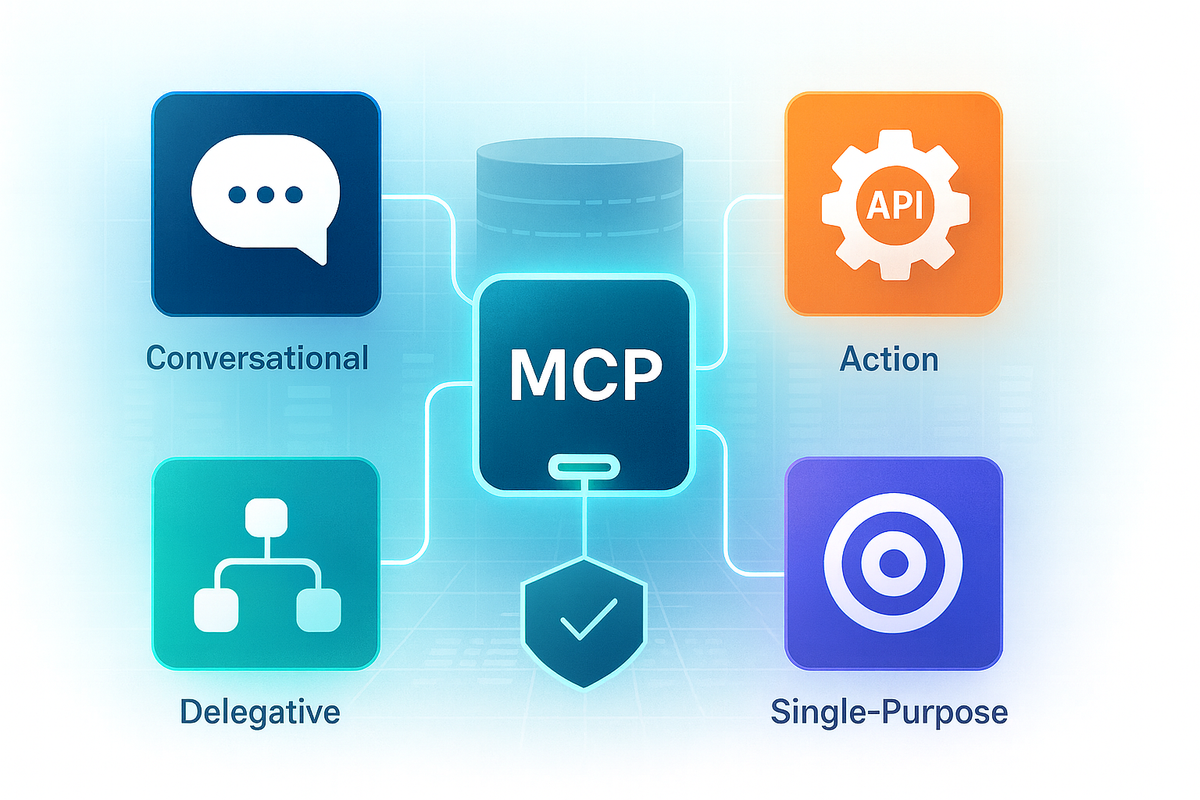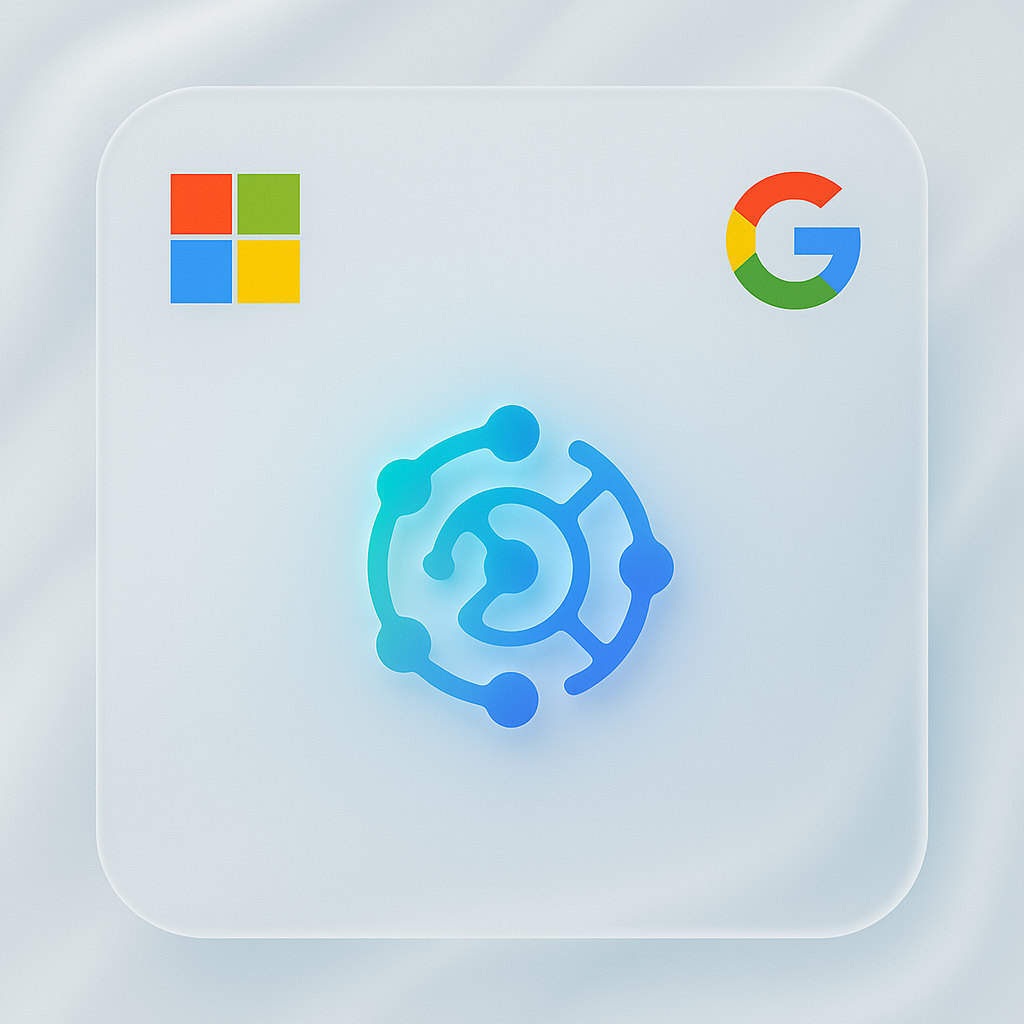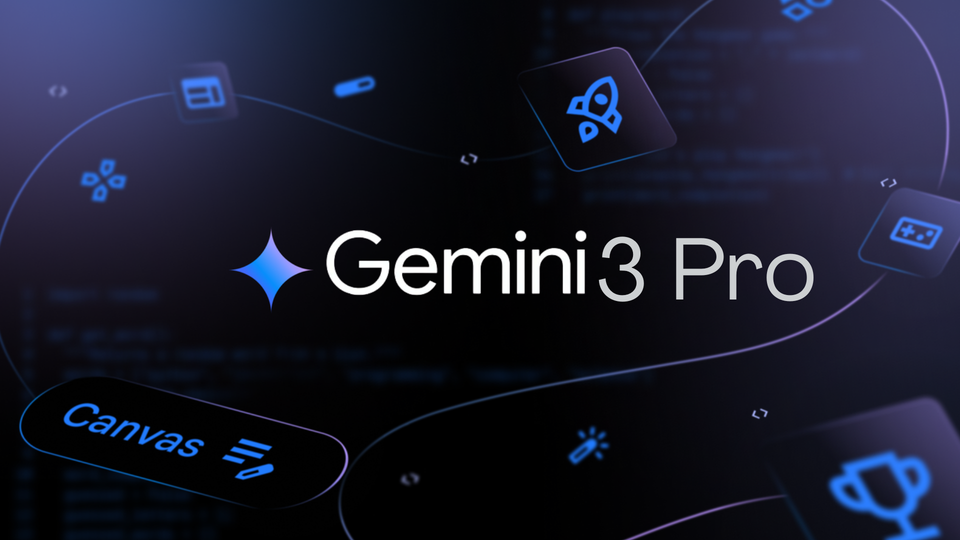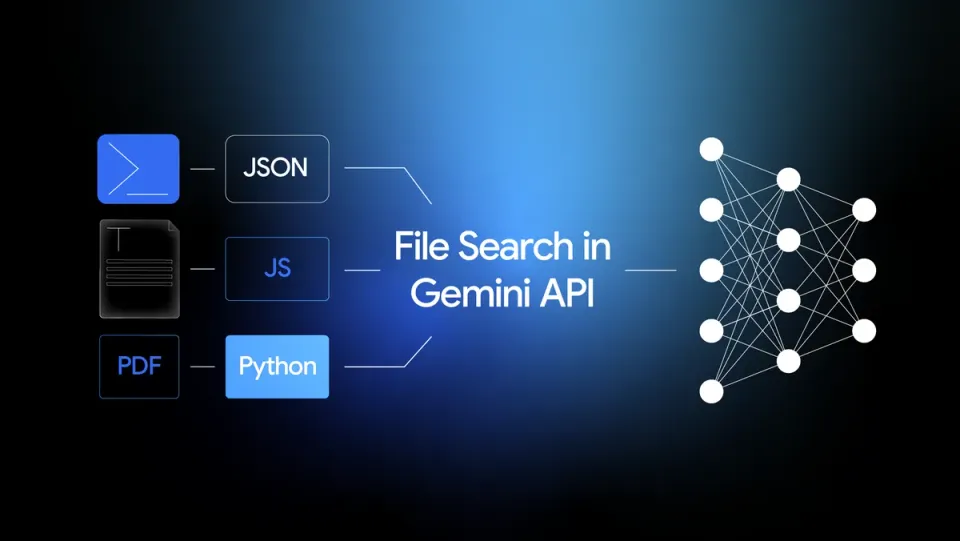The Four Faces of AI Agents and the Rise of MCP: A Practical Perspective

AI agents are moving from research demos into real-world applications. These days, tech giants like AWS with AgentCore, Microsoft’s Copilot, and vibrant open-source communities are converging on ways to deploy autonomous AI agents securely at scale. In this post, we’ll break down the four archetypes of AI agents, explore how they handle memory and context, and introduce the emerging Model Context Protocol (MCP) — a new standard often described as the “USB-C for AI tools” (an analogy that showed up multiple times in my research). We’ll also highlight practical backend integrations (Rails, FastAPI) that hint at how agentic AI is steadily making its way into admin workflows.
Four Archetypes of AI Agents
AI agents aren’t one-size-fits-all. Here are four common “faces” of agentic AI, each with distinct roles and behaviors:
Conversational Agents (Dialog & Reasoning)
These agents specialize in human-like dialogue think of chatbots, virtual assistants, or AI tutors. A conversational agent’s main goal is to interact through natural language, maintaining context over a conversation and providing useful answers or guidance. They excel at understanding questions, reasoning through problems in words, and generating coherent responses. For example, a support chatbot that answers customer queries or a tutoring agent that explains a concept step-by-step would fall into this category. Conversational agents are typically user-triggered (responding to user prompts in a Q&A or chat format), and while they can use tools, their defining feature is rich dialog and reasoning in language form.
Action Agents (Tool-Using Task Executors)
Action agents are doers, they take goal-oriented steps and interact with external tools or APIs to accomplish tasks. Rather than just chatting, these agents execute actions in an environment. For instance, an action agent might plan a multi-step job like “find today’s sales, email a summary, then update the dashboard,” and then actually call the necessary APIs or run code to make it happen. Frameworks like LangChain popularized this pattern, where an agent decides which Tool to invoke based on the situation. In other words, action agents combine reasoning with capabilities: they parse instructions, then call functions (APIs, database queries, web searches, etc.) to fulfill them. This category includes the “autonomous agents” that can chain multiple operations, for example, reading from a database and then sending an alert, without human intervention. Essentially, action agents bridge the gap between language and execution, turning intents into API calls or other operations.
To illustrate, LangChain defines an Agent as a decision-maker that chooses tools, with Tools being functions/APIs it can invoke. Action agents leverage such mechanisms to affect the world, not just describe it.
Delegative Agents (Orchestrators & Coordinators)
Delegative agents act as managers that hand off subtasks to other agents or specialized routines. In a multi-agent system, a delegative agent takes a high-level goal and breaks it into parts, assigning each part to another agent best suited for it. This is useful for complex workflows or when one “brain” should not handle everything. For example, consider an AI concierge delegating a refund request to a dedicated “refund-processing” agent, or a project manager agent parceling out tasks to a coding agent and a testing agent. OpenAI’s new Agents SDK explicitly supports this pattern: agents can transfer a task to a sub-agent while maintaining context continuity. The key idea is specialization and hand-off, the delegative agent knows its limits or the benefits of dividing work, so it routes requests to the right specialist (which might be another AI agent or a deterministic service). By chaining expert agents, delegative systems can tackle more complex, multifaceted problems. This approach keeps each agent’s role focused (e.g. one agent per role or expertise) and leverages “strength in numbers” via collaboration. Delegative agents herald a move from one big generalist model to swarms of cooperating models, each doing what it’s best at.
Single-Purpose Agents (Specialists for Specific Tasks)
Not every agent needs broad intelligence; many are single-purpose specialists. A single-purpose agent is designed to excel at one task or domain. It could be a document summarizer, a code completion bot, a SQL query assistant, or an email triage agent, anything narrowly defined. These agents typically follow a defined workflow or policy (often closer to a traditional “bot” but powered by an LLM’s understanding). They might not invoke a bunch of external tools or reason about arbitrary problems; instead, they’re very good at one job. For example, an AI that only categorizes support tickets or a scheduling assistant that only books meetings are single-purpose agents. They often can be slotted into existing software: think of an AI plugin that knows how to do one thing on command. Single-purpose agents are easier to trust and evaluate because their scope is limited. In practice, many production deployments of AI use this approach, rather than an all-powerful general agent, they deploy several micro-agents each handling a slice of functionality. This specialization can also make them efficient and controllable. (It’s common to integrate these via specific API endpoints or UI features, essentially extending apps with an AI-driven feature rather than a free-roaming AI.) Notably, these align with what some call “task-specific agents” in industry parlance, focused on automating one task or workflow extremely well.
Memory: Giving Agents a Brain (Short-Term vs Long-Term)
The challenge with AI agents is how to make them “remember” past information. Out-of-the-box, an LLM has no persistent memory, it only knows what’s in the prompt (conversation) up to its context window. Everything beyond that window is forgotten unless re-provided. Modern agents therefore employ memory systems to simulate long-term knowledge:
- Short-Term Memory: This is simply the context window of the model (the recent conversation or instructions it has “in mind”). Today’s models can have context lengths of 8k, 32k, or even up to 128k tokens in advanced versions. That might include the last few dozen turns of dialogue or the current task description and intermediate results. Short-term memory is fast and directly “in the head” of the model, but very limited, you can’t stuff an entire knowledge base or lengthy history indefinitely, because the window will run out (even 128k tokens can fill up quickly during a long session).
- Long-Term Memory: To go beyond those limits, agents use external storage, most prominently vector databases (a.k.a. vector stores). The technique known as retrieval-augmented generation (RAG) is commonly used: the agent or its platform will encode information (e.g. conversation snippets, documents, facts) into vector embeddings and store them in a database. Later, when the agent needs to recall something, it converts the query or context into a vector and searches for similar embeddings in that store. This way, the agent can fetch relevant pieces of past conversations or knowledge that were too large to keep in the prompt at all times. In effect, the vector store acts like long-term memory: a semantic index of things the agent has seen or should remember. The agent dynamically pulls in the most relevant facts from this store into the prompt to refresh its short-term memory. For example, if an agent chatted with a user last week about their preferences, it might have embedded those details.
In practice, implementing long-term memory might involve tools like Pinecone, Weaviate, Chroma, or FAISS to store embeddings. The agent’s framework (e.g. LangChain’s memory components) will handle retrieving the top-k relevant snippets and appending them to the prompt when needed. This gives the illusion of memory.
Why does this matter? Short-term memory alone means an agent can’t handle extended tasks or ongoing knowledge, it would forget earlier instructions or user context. By adding a retrieval-based long-term memory, agents can learn over time (e.g. remember user preferences, previous results, world facts) beyond a single session. It makes them far more useful and personalized. However, it’s not a perfect brain: the agent only knows what it has explicitly stored and retrieved. Mistakes can happen if the wrong memory is fetched or if the vector similarity is imperfect. Developers must design what to embed and when to update it. There are also data privacy considerations, e.g. deciding how long to keep memories and letting users opt out. Despite these challenges, memory is a cornerstone of practical agent design. Every archetype above benefits from memory (conversational agents recall dialogue, action agents keep track of steps/state, etc.), and frameworks provide abstractions to manage it. It’s often the differentiation between a “smart” seeming agent and one that endlessly repeats itself or contradicts earlier info.
Standardizing Tool Access: The Rise of MCP
One of the most exciting developments in the agent landscape is the Model Context Protocol (MCP) an open standard (spearheaded by Anthropic) that lets AI agents safely connect to tools and data. With MCP, an AI agent can plug into various services, file systems, databases, APIs, SaaS apps, in a consistent, secure way without custom-coding each integration.
What exactly is MCP? It’s essentially a capability interface defined over JSON-RPC. An AI application (the MCP client, e.g. Claude or another agent host) can discover what “capabilities” an MCP server offers and then invoke them with structured requests. Capabilities fall into three main categories:
- Tools: Functions or actions the agent can call (for example, “queryDatabase”, “sendEmail”, “getWeather”) along with their expected parameters. These are the verbs that actually do things (file operations, API calls, etc.).
- Resources: Data sources the agent can read from (think files, knowledge base entries, database records). These provide context to the agent, essentially read-only info that can be fetched as needed.
- Prompts: Predefined prompt templates or examples the agent can use for guidance. This could include a system instruction or a few-shot example that the server provides to help the agent interact with the tool effectively.
MCP formalizes how an agent finds and uses these. For instance, when an agent connects to an MCP server, it can call tools/list to get a list of available tool names and descriptions. Each tool has a schema for its input args, so the agent knows how to call it properly. Then the agent might invoke a specific tool via tools/call with JSON arguments. The server executes the action and returns a structured result. All of this happens through a standard protocol, not bespoke APIs for each new tool.
For example, imagine an MCP server that exposes a weather API. After connecting, an agent could do something like:
{
"jsonrpc": "2.0",
"id": 3,
"method": "tools/call",
"params": {
"name": "weather_current",
"arguments": {
"location": "San Francisco",
"units": "imperial"
}
}
}The above JSON-RPC request asks the server to execute the weather_current tool (passing in a city and unit system). The MCP server would respond with the result likely a JSON structure containing the weather info which the agent can then incorporate into its answer. Under the hood, the server handled translating the AI’s intent into a real API call (e.g. calling an actual weather service) and then gave the AI a clean result to use. This pattern massively simplifies tool integrations: AI developers don’t have to custom-wire every API and teach the AI how to parse each response. As one explainer put it, MCP lets agents plug into tools, data, and services no hacks or hand-coding so AI goes from just “smart” to actually useful in the real world.
Security & Governance: Because MCP is a real protocol (not just prompt-pattern hacking), it supports proper authentication and permissions. Connections can be local or over HTTP; the protocol recommends OAuth2 tokens or API keys for secure access. This means an enterprise can expose, say, a database or an internal CRM to an AI agent via MCP safely, the agent gets a scoped token that allows only certain queries or actions, and all calls are auditable. This is a huge improvement over past approaches where people might literally give an agent raw database credentials or hope it doesn’t mis-use a tool 😅. MCP’s design encourages scoped, explicit capabilities, the agent can only do what the server allows, and it must do so through well-defined methods. This opens the door for enterprise adoption of agents, since it aligns with IT security policies (e.g. using existing auth, logging all actions).
Ecosystem and Adoption: In just a few months since its release, MCP has gained significant traction. Anthropic’s Claude models support it natively, and many others are following. There’s a blossoming ecosystem of MCP servers for common tools e.g. GitHub, Google Drive, Slack, databases often community-built and shared on marketplaces. Companies are already using MCP to connect AI assistants to their stack: Block (Square) uses MCP for internal tools, Replit uses it so agents can read/write code in your IDE, and Sourcegraph & Codeium integrated it for coding assistance. Even Microsoft has embraced MCP, their Copilot ecosystem (Copilot Studio) supports MCP to let non-developers plug in data/tools without custom code. This level of buy-in suggests MCP (or something very much like it) is poised to become a defacto standard. OpenAI, notably, has been working on its own Agents SDK and function calling approach, which shares similar goals but even OpenAI’s paradigm could interoperate with MCP. For example, OpenAI’s Agents SDK now formalizes the idea of tools and even handoff between agents as we saw, so a standardized way to describe those tools (MCP) complements this development. In short, MCP is rising as the protocol that can glue together LLMs and the world’s software in a safe, consistent manner.
(For readers interested in the nitty-gritty: the MCP specification describes a two-layer architecture a data layer using JSON-RPC 2.0 for message structure, and a transport layer (STDIO for local, HTTP(S) for remote).
The data layer defines the methods for listing and calling tools, reading resources, etc., as well as client->server calls for things like requesting the AI to produce output (so servers don’t need direct LLM integration). It also has a notification system so servers can tell clients when something changes (e.g. new tool added). All of these details ensure that any MCP-compliant client can talk to any MCP server. If you implement a new MCP server for, say, your proprietary database, suddenly any AI app that understands MCP (Claude, perhaps ChatGPT with a plugin, etc.) can use it without custom integration. That’s a powerful idea for scaling AI tool use.)
Agents in Practice: From Demos to Backend Integrations
Six months ago, “AI agents” were often flashy demos like AutoGPT running in loops. Today, we see a clear trend toward practical integration of agents into real products and internal tools. Developers are leveraging frameworks and standards to embed agents in their workflows rather than as stand-alone novelties.
Open-Source Agent Frameworks: To build the archetypes above, there’s a growing arsenal of frameworks. The well-known LangChain library remains a popular choice it provides abstractions for tools, memory, and chains of reasoning, which can be composed to create both conversational and action agents. Microsoft’s AutoGen framework enables multi-agent conversations (agents talking to agents in a conversation-style to solve tasks collaboratively). CrewAI introduces a “team” of agents with distinct roles working together on tasks. Newer entrants like LangGraph, Semantic Kernel (by Microsoft), and OpenAI’s own Agents SDK (which evolved from their experimental “Swarm” project) are all converging on similar capabilities. The existence of these frameworks underscores that it’s no longer necessary to reinvent the wheel for every agent project you can pick a framework that fits your needs (lightweight vs. feature-rich, single vs. multi-agent, etc.) and get primitives for things like tool usage and memory out of the box.
Crucially, these frameworks also bake in “guardrails” and observability, which enterprises care about. For example, they may provide ways to validate an agent’s chosen action before execution, or to log every step it takes. This helps transition agents from a risky experiment to something you can trust in production.
Enterprise & Admin Integrations: A particularly promising direction (and one we’re personally excited about) is integrating agents into backend and administrative tools. Imagine having an AI assistant in your admin dashboard that can run reports, flag anomalies, or even execute safe routine tasks via natural language. Thanks to protocols like MCP, this is becoming feasible. For instance, there’s an open-source gem called Rails MCP Server that exposes a Ruby on Rails application’s internals (models, database, routes, etc.) through MCP. An LLM agent (like Claude) connected to this server can literally interact with the Rails app: reading code, querying the database, and answering questions about the app’s data or behavior all in a controlled way. This was initially pitched as a developer assistant (imagine asking “Hey AI, what does this method do?” and it reads the code for you via the MCP interface). But you can also use it in an ActiveAdmin context i.e., to let an agent safely execute admin-approved actions. The gem lets you define what tools the AI has (perhaps “findUser(email)”, “resetPassword(user_id)” as allowed functions), and then an admin could ask the AI to perform those operations conversationally. The agent remains within the guardrails provided by MCP and the server’s permission settings, so it can’t go rogue. This concept turns an admin panel into more of a dialogue interface extremely powerful if done right.
Similarly on the Python side, the FastAPI MCP project allows you to wrap a FastAPI application’s endpoints as MCP tools automatically. With a few lines of code, every API in your FastAPI app can be made discoverable to an AI agent as a capability. This means if you have, say, a FastAPI-based microservice, you could connect an AI and it would see a list of endpoints like create_user, get_sales_report, etc., and call them as needed. It essentially provides an instant bridge between an LLM and your API, so you can talk to your backend with natural language. Of course, you’d still enforce auth and scope (FastAPI MCP supports adding authentication and selective exposure of endpoints), but the heavy lifting of interfacing the AI with your service is handled. We’re beginning to see the first examples of AI agents embedded in internal tools this way e.g. a conversational assistant in a company’s dashboard that, behind the scenes, uses MCP to run queries and commands on the company’s systems, with proper access control.
Why is this a big deal? It signals that agentic AI is transitioning from a cool toy to a practical part of software architecture. Instead of rigid UIs or manual scripting, admins and developers can increasingly ask an AI to do something in plain language, and if it has the sanctioned tool/API access, it will just do it. Early adopters report huge productivity wins for example, automating tedious support tasks or speeding up debugging by querying the system via AI. It’s also a way to democratize data and operations: non-technical team members might use an AI agent to generate a report or cross-check data, tasks they’d otherwise need a SQL query or help from engineering to do.
Conclusion & Forward-Looking Perspective
The four faces of AI agents we discussed conversational, action-oriented, delegative, and single-purpose often overlap in practice. Real-world systems might combine them (e.g. a customer support AI that is conversational with the user but also an action agent when it files tickets or retrieves data, and perhaps delegative when escalating issues). The emergence of standards like MCP and a rich ecosystem of frameworks is accelerating the convergence of these capabilities into robust solutions. We are essentially witnessing the evolution of AI agents from academic curiosities into “full-stack” components of software systems, akin to how web services or microservices became standard parts of apps.
Our perspective: Agentic AI is moving from niche demos to mainstream infrastructure. In the near future, it’s easy to imagine a company’s internal systems all having an AI copilot: your CRM, your DevOps console, your BI analytics each might have an agent that knows how to use that system’s MCP interface to answer questions or perform actions. This will likely shift how we design software UIs (why click through forms if you can just ask the system to do X for you?) and how we automate processes. The focus will increasingly be on defining safe capabilities and letting the AI figure out how to use them, rather than hard-coding procedural logic for every scenario.
Of course, there are challenges ahead: ensuring reliability (agents still make mistakes or need oversight), managing security (making sure an AI doesn’t overstep its permissions), and user experience (when do users prefer to interact with an AI vs. a GUI?). But the momentum is clearly toward deeper integration. As standardized protocols (MCP and perhaps others) take hold, we expect to see marketplaces of AI tools and cross-compatibility that make agents extremely plug-and-play.
Call to action: For developers, now is an excellent time to get hands-on with these technologies. If you’re curious, try wiring up a simple agent in your own project. You could, for example, spin up the FastAPI MCP adapter and see how an LLM would call your API, or use the Rails MCP Server gem to give an AI access to a toy database. Experiment with frameworks like LangChain or AutoGen to prototype an agent that uses a couple of tools, or test out OpenAI’s Agents SDK if you have access it can show you how to orchestrate multi-agent handoffs in a few lines. By engaging with these, you’ll not only build something cool, but also contribute to figuring out best practices.
The AI agent revolution is here, but it’s in a formative stage where developers’ choices will shape what “pattern” becomes standard. In the same way web developers in the early 2000s shaped REST and other patterns, AI developers today can influence how agents are built and deployed. We encourage you to join the conversation (and the coding). Whether it’s adopting MCP for a use-case, sharing an open-source agent tool, or simply giving feedback on these frameworks, your involvement matters.
In sum, the landscape is rich and rapidly evolving. The four archetypes help us reason about what an agent can be, and MCP is showing us how those agents can safely connect to the world. The next step is putting it all together and bringing agentic intelligence into the fabric of everyday software. It’s an exciting journey, and it’s just getting started so take your ideas and build with it!
References
- Anthropic - Model Context Protocol (MCP) Introduction - the “USB-C for AI” concept and overview.
- Anthropic - MCP Architecture Overview - technical breakdown of tools, resources, and prompts.
- Edwin Lisowski, MCP Explained: The New Standard Connecting AI to Everything (Medium, Apr 2025) - high-level overview of MCP’s purpose and early adopters (Block, Replit, Sourcegraph, Microsoft Copilot, etc.).
- Manish Shivanandhan, How AI Agents Remember Things: The Role of Vector Stores in LLM Memory (FreeCodeCamp, 2024) - explains short vs. long-term memory and how vector databases enable recall beyond context windows.
- Aman Raghuvanshi, Top AI Agent Frameworks in 2025: LangChain, AutoGen, CrewAI & Beyond (Medium, May 2025) - details popular frameworks and their features.
- PromptHub Blog, OpenAI’s Agents SDK vs Anthropic’s MCP (Aug 2025) - covers OpenAI’s new agent features (delegation, handoffs) and how they align with MCP.
- MindsDB Blog, Types of AI Agents (Aug 2024) - definitions for task-specific agents and conversational agents, aligning with our single-purpose and dialog archetypes.
- GitHub - Rails MCP Server - gem that exposes Rails apps to MCP (models, DB, routes, etc.).
- Dev.to - FastAPI MCP Project Intro - how to wrap FastAPI endpoints as MCP tools.



